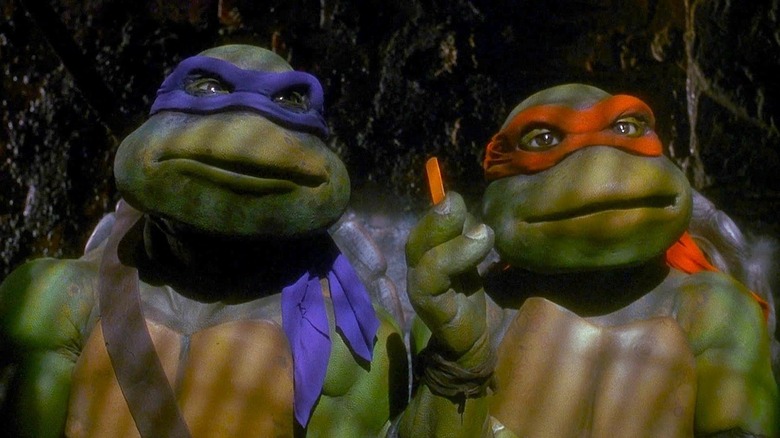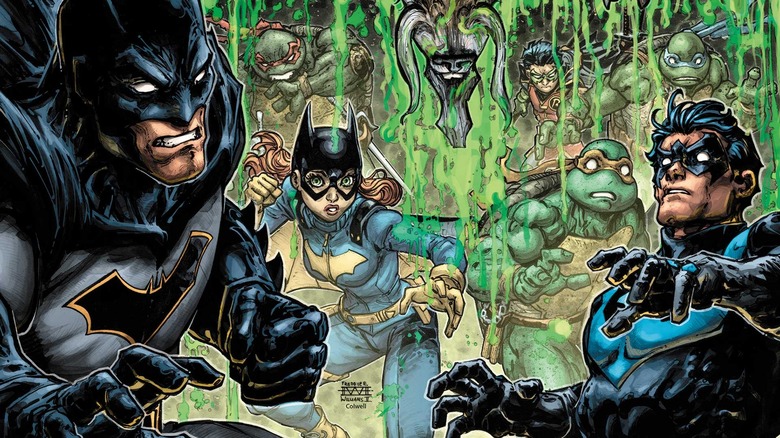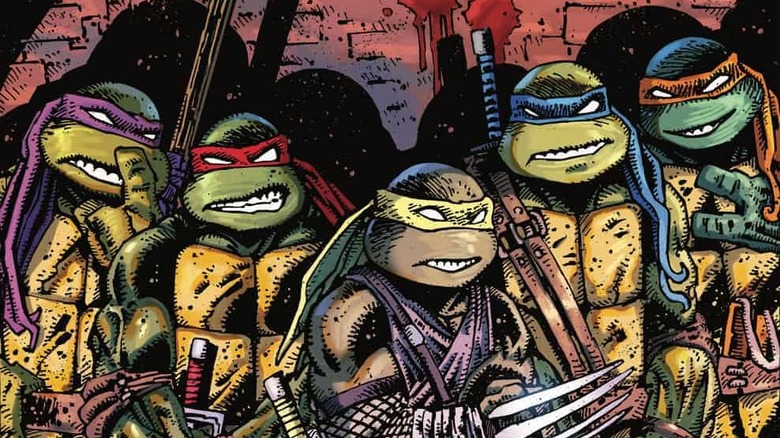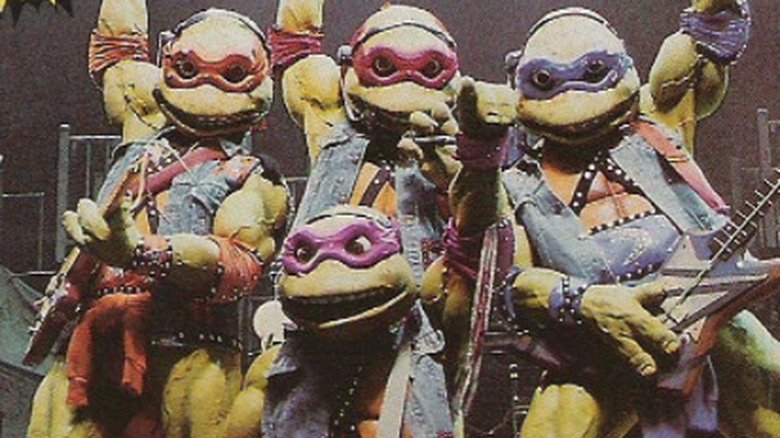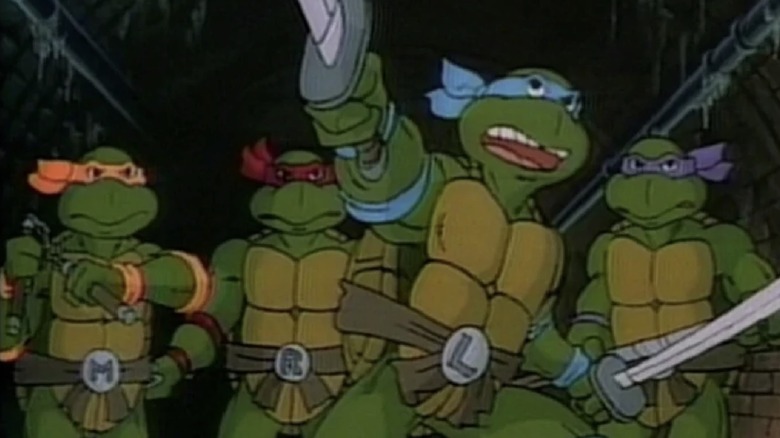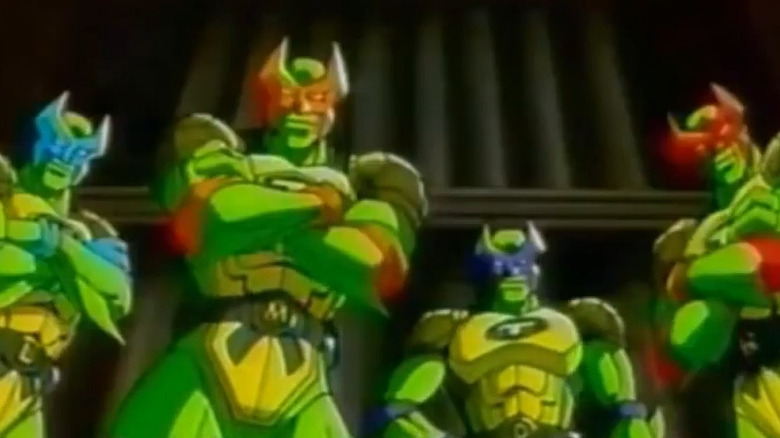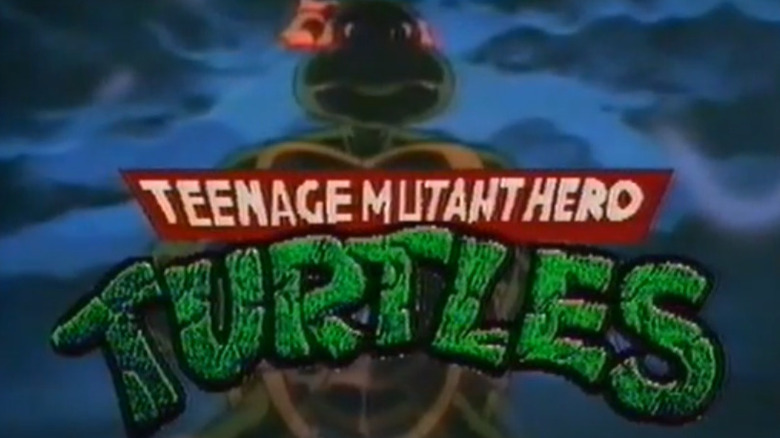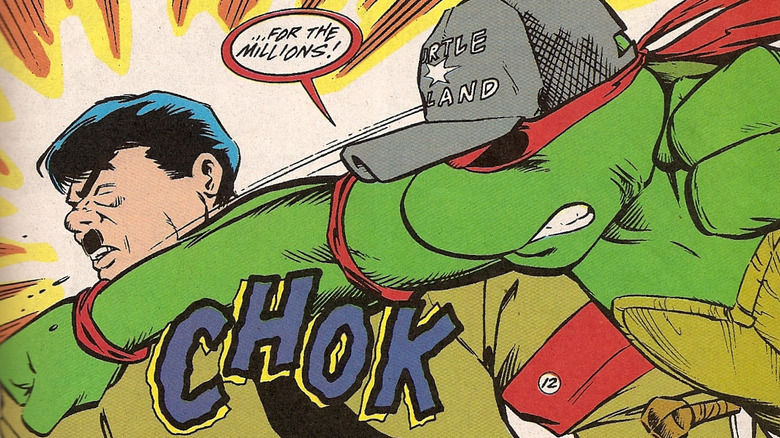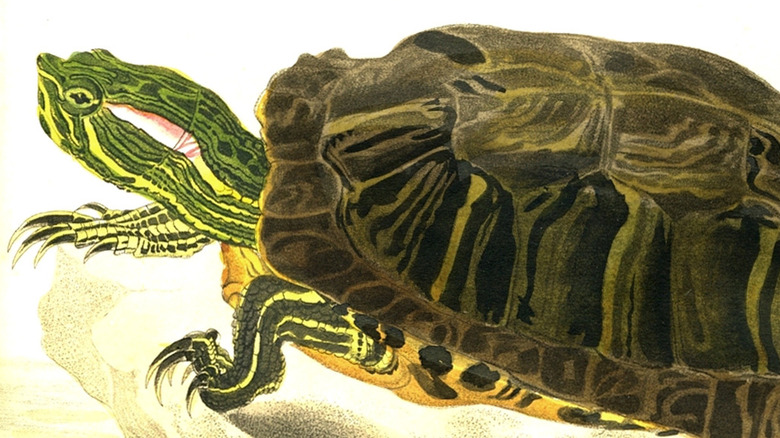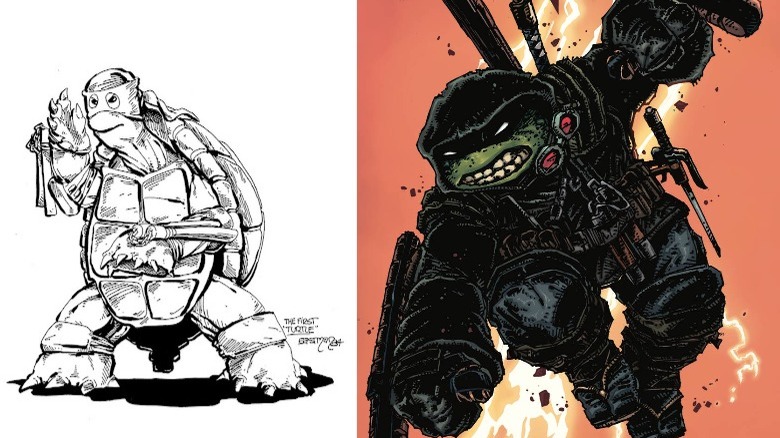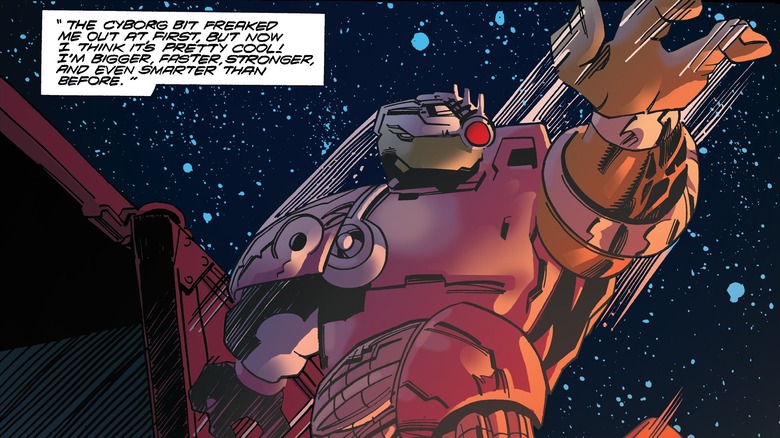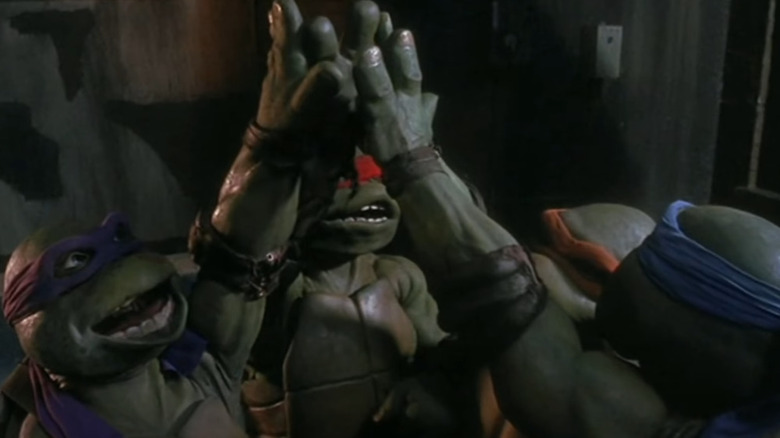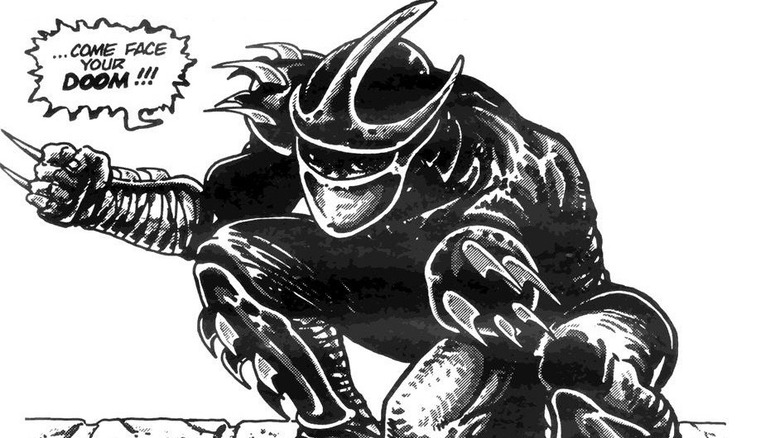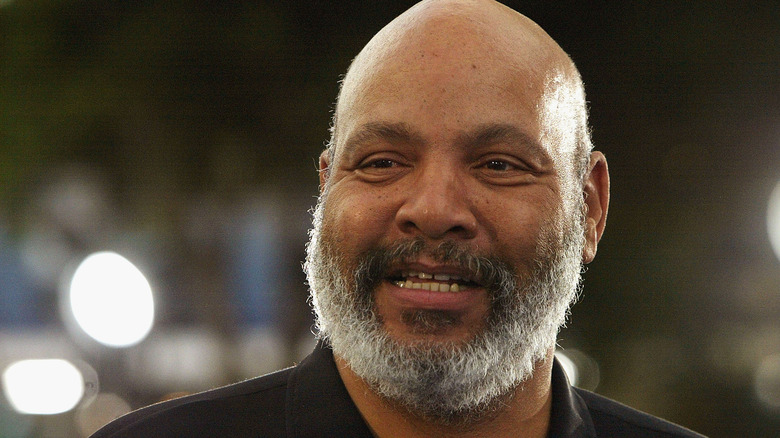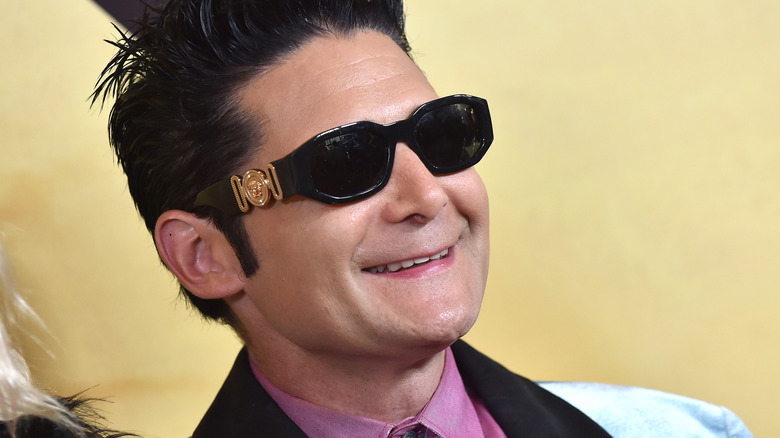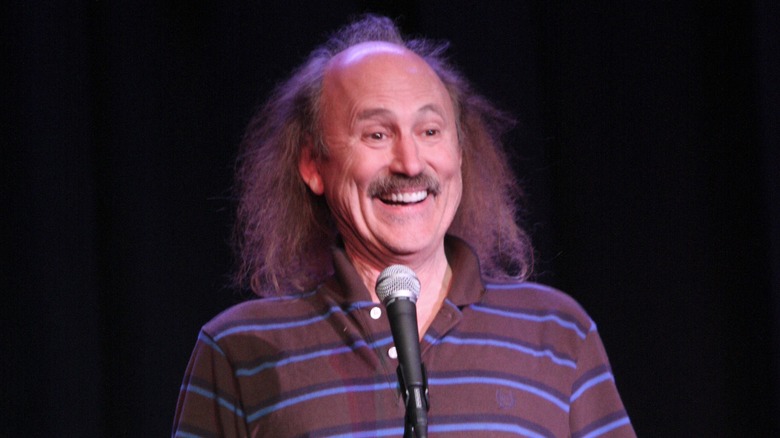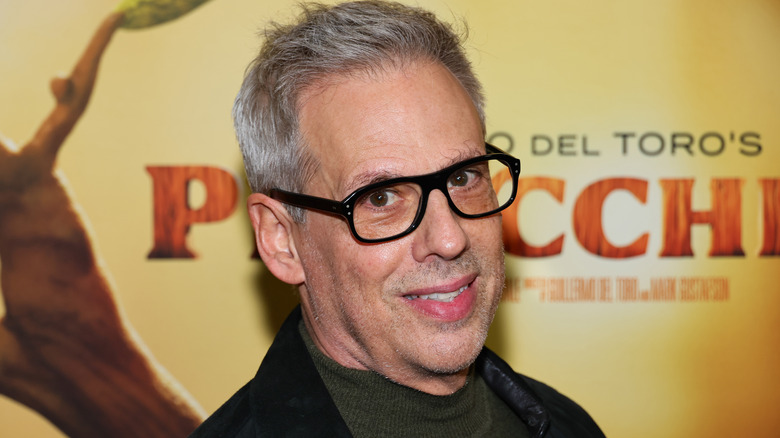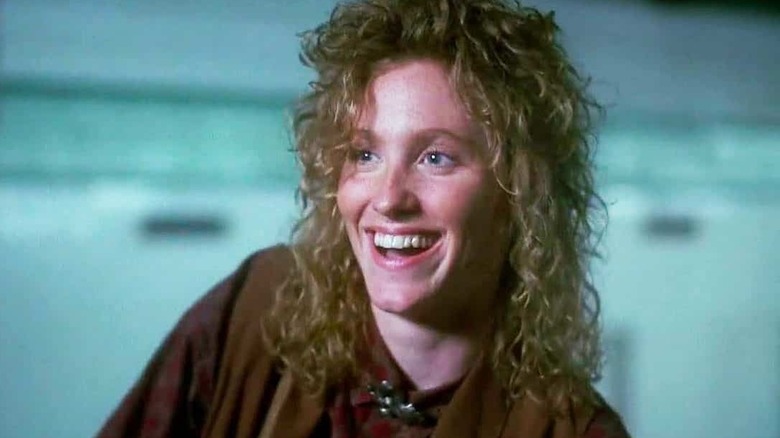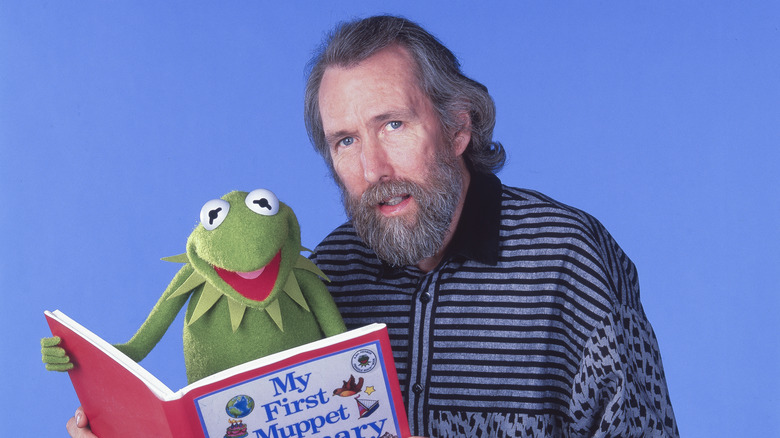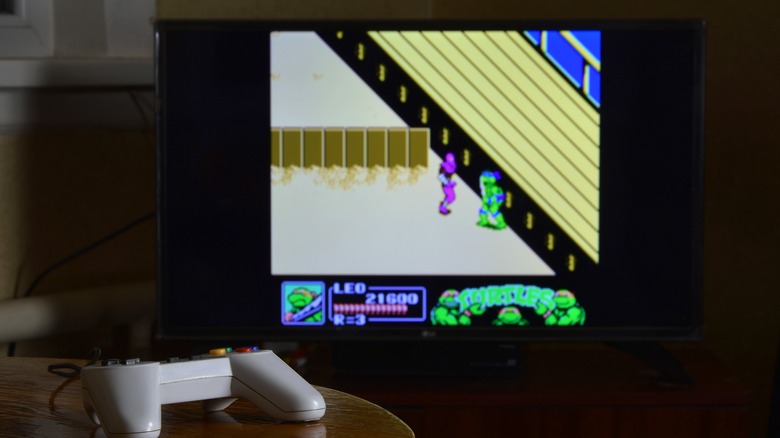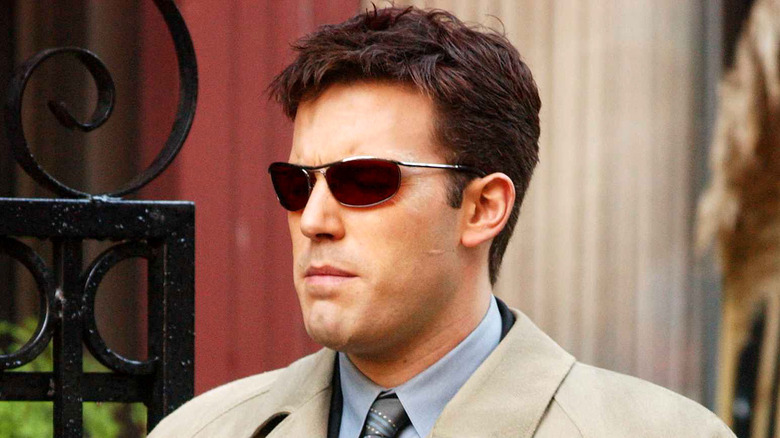20 Teenage Mutant Ninja Turtles Details That'll Leave You Shouting Cowabunga
"Teenage Mutant Ninja Turtles" is the most successful independent comic book of all time, one that series creators Kevin Eastman and Peter Laird could never have imagined journeying from black-and-white parody to global pop culture phenomenon. Nowadays, everybody knows the Turtles — many having grown up loving a version of them from the cartoons, films, or comics.
Indeed, the Heroes in a Half-Shell have seen numerous reboots, iterations, and reinterpretations over the decades. At their core, however, they've always been the same, regardless of whatever fictional universe they're in: four heroic, anthropomorphic turtles trained in Ninjutsu who "strike hard and fade away into the night." While the story of their genesis and rise to international success has been told time and again, there are many peculiar (and little-known) facts about Leonardo, Raphael, Donatello, and Michelangelo that make the TMNT phenomenon even more fascinating.
Here is the untold truth of the Teenage Mutant Ninja Turtles, the world's most fearsome fighting team.
The Turtles have been published under numerous comic book companies
The Turtles made their debut in May 1984, in the pages of their self-titled comic. Eastman and Laird self-published it under the banner of Mirage Studios, a name they reportedly chose because they had no actual publishing company. In 1987 the Turtles got their own cartoon show, and their popularity began to boom; a year later, Archie Comics launched a comic book series ("Teenage Mutant Ninja Turtles Adventures") to capitalize on the show's success.
The Turtles' original Mirage series ran for two volumes. A third volume — which was brutal, violent, and largely considered by fans as non-canon — was published under Image Comics in 1996. The series returned to the Mirage fold with Volume 4, which ran from 2001 to 2014. A tie-in comic to the 2003 TV series was published by Dreamwave, which only lasted for seven issues. Since 2011, IDW Publishing has been putting out a TMNT comic, which has had more than 250 issues.
Aside from their different ongoing series, the Turtles have also made team-up appearances in comics published by Dark Horse (a crossover with the Flaming Carrot), Boom! Studios (when they met the Mighty Morphin Power Rangers) and DC (multiple pairings alongside Batman). The Turtles have yet to officially appear in the Marvel universe — ironic, considering how their very first story was written in a way that tied in to the Marvel hero Daredevil's origin.
The Turtles have added a fifth member -- twice
Any TMNT fan knows their origin story: Four turtles end up in the care of martial artist Hamato Yoshi (or his pet rat) in the sewers of New York. A canister of ooze falls into the sewers, transforming the Turtles and their master. The ninja warrior teaches his reptilian "sons" how to fight, and names them after Renaissance artists. However, there have been at least two significant occasions where the crime-fighting quartet welcomed a fifth mutant Turtle to their team — and in both instances, that new member was a girl.
1997 saw the release of the live-action TV show "Ninja Turtles: The Next Mutation." This introduced a major change to the TMNT mythos in the form of Venus de Milo, the fifth Turtle. Venus actually mutated alongside the other four, but was adopted and raised by a Chinese Shinobi master. She wore a braided light blue mask, and was a skilled magic practitioner. She didn't quite catch on; in fact, legend has it that Peter Laird hated her with such a passion that he banned her from appearing in any future Turtles adaptations.
About two decades later, the idea of a fifth Turtle would reappear, this time with a twist. First appearing in 2015's "Teenage Mutant Ninja Turtles" #51, the IDW series introduced Jennika, a former assassin who was mutated when Leonardo and Donatello gave her their blood to save her life. She wears a yellow bandana and uses a pair of claws evocative of the Marvel hero Wolverine.
The Turtles became a Pizza Hut-sponsored rock band
When the TMNT became a pop culture juggernaut, it seemed like the franchise could do no wrong. The cartoon was a mega-hit, the movies made fans happy, and toy sales were off the charts. That's likely what brought about the idea of a live concert tour, sponsored and promoted by Pizza Hut.
In 1990, the "Coming Out of Our Shells" tour featured the four Turtles trading in their ninja weapons for musical instruments. Leonardo was on the bass guitar, Donatello was the keyboardist, Raphael was the percussionist, and Michelangelo was the guitarist and lead vocalist. An actual band — dressed up in infamously bad TMNT costumes with denim vests — went on a year-long tour across the United States, performing original songs on stage. Their first performance was a live pay-per-view broadcast from Radio City Music Hall in New York.
The central story of the musical tour revolved around the Turtles' nemesis, the Shredder, and his plan to steal the world's music. Needless to say, the "Coming Out of Our Shells" tour certainly wasn't a highlight for TMNT fandom. At the very least, however, the tour was successful enough to merit a smaller follow-up trek in 1992. Plus their short-lived musical career did earn the brothers a guest spot on "The Oprah Winfrey Show," resulting in perhaps the single most cringe-worthy moment in TMNT history.
Chuck Lorre wrote the Turtles' 1987 theme song
Most people know Chuck Lorre for his work on popular sitcoms such as "Roseanne," "Two and a Half Men," and "The Big Bang Theory." However, one of the lesser-known accomplishments of the "King of Sitcoms" was his major contribution to the TMNT franchise: He wrote the iconic theme song for the 1987 cartoon.
In an interview with IndieWire, Lorre shared how, three decades ago, he and his co-writer were faced with an incredibly short turnaround time for the song: "[I]t got written by me and my [then-writing] partner Dennis Brown. We wrote it in an afternoon and we recorded it in an evening." At the time, Lorre wanted to kick-start his career writing songs and scripts for TV shows, and was particularly interested in the TMNT theme song gig (via Archive of American TV). As it turned out, someone else got the job; however, they didn't complete the task, leaving the production team with no choice but to contact Lorre and give him the assignment on a tight 48-hour deadline. Lorre and Brown read the Mirage comics for inspiration, then made the most out of their meager $2,000 budget by booking a studio in Los Angeles from midnight until 8 a.m.
Lorre also revealed that originally, the "TMNT" cartoon was only going to last for six episodes. "The fact that the song still means anything to anyone anywhere is just wonderful," he said. "It's become this phenomenon I'm very proud to be attached to."
The Turtles became anime stars with transforming abilities
The worldwide popularity of the TMNT franchise has allowed for some truly diverse interpretations of the characters. Perhaps one of the best examples was the Japanese animated special "Teenage Mutant Ninja Turtles: Legend of the Supermutants" (or "Mutant Turtles: Superman Legend"). This two-part, direct-to-video OVA (original video animation) was released in 1996, and was created as a companion cartoon to the Metal Mutant and Supermutant action figures. The limited series also brought back some of the voice actors from the Japanese dub of the 1987 cartoon.
"Legend of the Supermutants" sees the four Turtles gaining the ability to transform into lean, armored "Super Turtles" through the use of mystical stones called MutaStones. Their cartoon villains — the Shredder, Krang, Bebop, and Rocksteady — could also transform using the MutaStones; the Shredder in particular had a striking dragon-like alternate form as Devil Shredder, complete with gigantic wings. Further strengthening the comparisons between "Legend of the Supermutants" and standard tokusatsu/Super Sentai fare is the four Super Turtles' ability to merge into a stronger entity called the Turtle Saint.
The second episode was even more bizarre: It depicted the four Turtles as having the power to shift into elemental animal forms through the use of mystical suits of armor called Metal Beasts.
To enter the British market, the Turtles made some huge changes
The Turtles successfully took the pop culture world by storm in the '90s, but that doesn't mean the franchise didn't have to make some compromises along the way. One of the most infamous examples is the retitling of the series — and the replacement of one of the leads' signature weapons — in order to make it past censors in the United Kingdom.
The British government was particularly iffy about portrayals of violence in various media. For some reason, the idea of the ninja — a "popular subject matter in Western entertainment" in the '80s and '90s, according to Lifehacker — just didn't sit right with U.K. censors. Thus, in the U.K. and other European countries, the name "Teenage Mutant Hero Turtles" was on the title card of the TV show, and was all over books, toys, and other merchandise.
That wasn't the only adjustment that the Turtles had to make for British audiences. U.K. censors also weren't keen on Michelangelo's nunchucks, which were strongly associated with ninjas. That's why Michelangelo's main weapon in the cartoon became a grappling hook. This censorship rule also necessitated a rather odd edit in the movie "Teenage Mutant Ninja Turtles II: The Secret of the Ooze": Censors mandated that a scene showing Michelangelo swinging sausage links as makeshift weapons be cut from the final film. An amusing note from the censors read: "Reduce to minimum dazzling display of swinging sausages indistinguishable from chainsticks."
In the comics, the Turtles unknowingly helped end World War II
The cover of Marvel's "Captain America Comics" #1 features the Sentinel of Liberty punching Adolf Hitler in the face, a powerful image that immediately told the reader what the character stood for. Interestingly enough, a Teenage Mutant Ninja Turtle had a similar encounter in the comics — one that, in the Turtles' reality, actually helped put an end to the second World War.
In an issue of Archie Comics' "Teenage Mutant Ninja Turtles Adventures," the future versions of Leonardo, Donatello, and Raphael use a Time-Slip Generator to go back to the past and stop a human brain in a robotic suit from wreaking havoc. They land in Germany, coming face-to-face with none other than Hitler himself; it's also revealed that the brain powering the robot belongs to the mad tyrant.
A scuffle quickly ensues, during which the one-eyed future Raph gets the opportunity to deck the dictator. Upon retrieving the brain, the Turtles quickly open up a portal to their own time, but not before convincing Hitler that they are brain-snatching "demons." In a vain attempt to foil their plans, Hitler promptly responds by pulling out a Luger and blowing his brains out.
TMNT's popularity played a role in a real-world invasive species crisis
The most popular species of pet turtle in the world is arguably the red-eared slider. Their cheap price and availability made them easily obtainable in the U.S. until 1975, when concerns about salmonella negatively impacted the turtle trade. However, less than two decades later, the demand for pet turtles soared anew because of the TMNT craze — and this worsened a major invasive species problem that continues to plague the world's ecosystems to this very day.
Based on reports cited by the U.S. Geological Survey, there is, indeed, a direct connection between the TMNT "television cartoon craze" and the sudden boom of red-eared slider populations worldwide. U.S. turtle exports from 1989 to 1997 experienced a staggering 257 percent increase as more children across the world wanted to have their very own turtle pets at home. Here's the problem: When young pet owners would often decide that they no longer wanted the responsibility of caring for their turtles, they would release them into nearby bodies of water.
This is a terrible idea, because red-eared sliders are infamous not just for their tendency to carry disease, but also for being bigger and more competitive than many native turtle species. When an invasive species is introduced into a new environment, it usually spells doom for other species in the ecosystem; in fact, invasive species are the second greatest driver of biodiversity loss worldwide.
Michelangelo is both the first and the last Turtle
The seeds of the TMNT franchise were planted in 1983, thanks to a random illustration that Kevin Eastman sketched while he was hanging out at Peter Laird's place. At the time, they were working on a different comic; however, the ridiculousness of Eastman's doodle — a turtle wearing a bandana and standing on two legs, with a pair of nunchucks strapped to his arms — prompted the two to hilariously outdo each other with one drawing after another. That is, until they realized that there might be potential in this goofy concept. In other words, Michelangelo (formerly misspelled as "Michaelangelo" in the cartoons and assorted merchandise) became the prototype Turtle.
Michelangelo is often portrayed across various media adaptations as the least serious among the Turtles, the comic relief that balances out Leonardo's stoicism, Raphael's ill temper, and Donatello's awkward nerdiness. In most iterations, he's also the least skilled fighter, despite his tremendous unrealized potential. Perhaps that's why Eastman and Laird thought it would be appropriate for him to be the lone surviving Turtle, in a dystopian future story that they'd been planning since 1987.
2020's "TMNT: The Last Ronin" features a much older Michelangelo, on a mission to avenge his brothers after the Shredder's descendants killed them. Armed with his brothers' weapons, this Michelangelo is violent, fearless, and determined to take out the Foot clan. There's something very unsettling about seeing the class clown in a different, brutal light.
Donatello keeps getting cyborgized; Raphael keeps losing his left eye
Donatello has traditionally been portrayed as the tech-savvy Turtle, and so it makes sense that the brainy mutant would figure out how to cheat death by upgrading his mortal shell. What's interesting, though, is how frequently this has happened to him in various continuities.
For instance: The third volume of the TMNT comic (published by Image Comics) opened with Donatello gunned down and barely hanging on to life. He survived his injuries — and being dropped from a helicopter — by merging with one of his cyborg assailants. Meanwhile, the IDW series showed Donatello nearly being killed by Bebop and Rocksteady; he avoided death when his soul was transferred into the robot turtle Metalhead. This cyborgization was temporary, it would turn out, and he was eventually restored to his fully-healed body. The 2012 "Teenage Mutant Ninja Turtles" cartoon showed a similar fate for Donatello in the future: When a mutagen bomb destroyed his physical body, he transferred his consciousness into his Metalhead robot and adopted the identity of "Donbot."
Raphael, on the other hand, seems to have a knack for losing his left eye. In the alternate futures of the Mirage, Archie, Image, and 2003 cartoon continuities, the hot-headed Turtle is seen sporting an eyepatch.
The Turtles' iconic catchphrase earned them a lawsuit
Ask any fan of the 1987 "TMNT" cartoon to tell you a word that they connect with the series, and there's a good chance they'll respond with a single, iconic catchphrase: "Cowabunga!" A nonsensical term that was coined by Buffalo Bob Smith (initially as "kowabonga") in 1949 for "The Howdy Doody Show," surfers in the 1960s started using the phrase more frequently until it became strongly associated with surfing culture. There's no doubt, though, that the Turtles' use of "Cowabunga!" helped cement its popularity in the eyes (and mouths) of the general public.
According to David Wise, head writer of the 1987 TMNT series, he wrote "Cowabunga!" into Michelangelo's dialogue because he saw the Turtle "as this Harpo Marx-surfer type floating above everything like Sean Penn in 'Fast Times at Ridgemont High.'" When the party-loving reptile uttered the phrase in the pilot episode, it just clicked — and "Cowabunga!" became the Turtles' battle cry.
However, this prompted Buffalo Bob to sue Eastman and Laird for their use of the term he invented. Eventually, they settled out of court for $50,000, but due to its enduring popularity in the TMNT mythos, the phrase continues to pop up in different TV incarnations of the team.
The Shredder wasn't supposed to be a recurring Turtles villain
Aside from serving as a love letter to the various versions of the TMNT, the 2009 animated film "Turtles Forever" made one thing clear: In every universe that has the Turtles, there's an iteration of the villainous Shredder to serve as their foil. However, this wasn't always meant to be the case, if the first-ever TMNT story is any indication.
In their 1984 debut, the Turtles faced off against the Shredder (aka Oroku Saki) in a rooftop battle and the armored ninja was thrown off the building while holding a thermite grenade, resulting in his off-screen death. Some time later, the villain returned to pester the Turtles anew, resurrected by the Foot clan. In a final showdown, Leonardo managed to cut off the Shredder's head, apparently killing him for good. The Shredder's specter would continue to haunt the brothers, however, with Raphael even adopting the villain's mantle at one point.
Of course, in virtually every other incarnation of the Turtles, the Shredder has been portrayed as their main antagonist. Nowadays, many recognize the Shredder as the yin to the Turtles' yang, like the Joker to Batman or Lex Luthor to Superman. Not too bad for a guy named after an office machine and covered with glorified cheese graters.
The Fresh Prince of Bel Air's James Avery voiced Shredder
There's a bit of a crossover between two beloved and definitive early 1990s television series. The original animated "Teenage Mutant Ninja Turtles" TV show first aired in syndication from 1987 to 1996. Actor James Avery provided the voice for the titular turtles' arch-enemy Shredder in more than 110 episodes, while also portraying the occasional minor and ancillary character. Avery, who died in 2013, was probably best known for one of his live-action roles, that of wealthy judge and father figure Philip "Uncle Phil" Banks, on Will Smith's hit NBC sitcom "The Fresh Prince of Bel-Air" from 1990 to 1996.
"Shredder was basically a straight-ahead villain, but ... there were levels that I found as an actor to play him," Avery told The Hollywood Reporter. "Everyone was just so smart and witty. I can't explain to you what fun it was. It was like the old days. It was like old radio theater. It was just a joy."
Corey Feldman was a Teenage Mutant Ninja Turtle (twice)
In the 1980s, Corey Feldman was both a teen idol and prolific actor. After breakout roles in well-received films like "The Goonies" and "Stand By Me," he teamed up with the similarly named Corey Haim for "The Lost Boys," "License to Drive," and "Dream a Little Dream." At the dawn of the '90s, Feldman joined a different team and voiced bo-wielding Donatello in the first live-action "Teenage Mutant Ninja Turtles" movie.
In 2013, Feldman returned to the "Ninja Turtles" franchise, once more as a voice actor, but in a completely different role. He joined the cast of Nickelodeon's "Teenage Mutant Ninja Turtles" TV series reboot playing Slash, the imposing and monstrous mutated version of Raphael's pet turtle, Spike. "He turns into an equal ally with the Turtles in size, stature, and personality," Feldman boasted to TV Guide (via The State Journal-Reporter).
There could have been a TMNT starring big-name comedians
"Teenage Mutant Ninja Turtles" began as a black-and-white, independently published comic book in 1984. By 1988, it was a franchise and a sensation, expanding to an animated TV series and toy and merchandise lines generating revenues of more than $43 million. But despite success in publishing, on television, and in stores, "Ninja Turtles" originators Kevin Eastman and Peter Laird couldn't get Hollywood interested in a movie adaptation.
At that point, the duo had received just one significant film offer. Roger Corman, a producer of more than 500 low-budget B-or-lower-grade movies, pitched "Teenage Mutant Ninja Turtles" as a modest film with a main cast composed of 1980s-era comedy all-stars. "Sam Kinison and Gallagher, and Billy Crystal, and Bobcat Goldthwait, wearing sort of green paint and shells and being the Turtle characters," Eastman recalled to The Ringer. "It was a very hilarious treatment and concept." That film never made it past the idea stage, and shortly after Corman took his shot, Hong Kong-based Golden Harvest signed on to finance what would become the 1990 "Teenage Mutant Ninja Turtles" movie.
Only one live-action Ninja Turtle was performed by a single actor
The 1990 "Teenage Mutant Ninja Turtles" film brought to life the anthropomorphic turtles who had previously been seen only in the pages of comic books and on a traditionally animated TV cartoon series. The well-known Turtles came to the big screen in the form of bulky humanoid turtle costumes that restricted movement for the actors inside, who were responsible for the movements of Leonardo, Michelangelo, Donatello, and Raphael. To ensure crisp, audible dialogue, other actors provided the voices of the Turtles, recorded after the fact.
Multiple sets of actors and puppeteers were required to portray the Teenage Mutant Ninja Turtles in the franchise's first movie. In the suits, for example, were David Forman (Leonardo), Michelan Sisti (Michelangelo), and Leif Tilden (Donatello). Josh Pais suited up to portray Raphael while also providing his voice, the only double-duty cast member in the film. Heard, but acting with his face obscured, Pais went on to build a career as a well-employed character actor. He's likely best known for his roles as Gaila on "Star Trek: Deep Space Nine," George Berber on "Damages," various characters on multiple "Law and Order" shows, and Stu Feldman on "Ray Donovan."
The Robin Williams -- April O'Neil connection
In 1990, actor Judith Hoag got her big break with roles in two back-to-back movies: the Robin Williams sleazy car salesman comedy "Cadillac Man" and "Teenage Mutant Ninja Turtles." Her work on the first film prepared her for the latter. Hoag got the news that she'd play reporter and Ninja Turtles human ally April O'Neil during the final days of shooting on "Cadillac Man," but was reluctant to tell her costars about the project because it was still a relatively obscure property.
Williams managed to coax it out of Hoag. "I said what the title was and Robin went out of his skin," Hoag said during an appearance at the Tulsa Comic Expo in 2016 (via Tulsa World). "He had the very first comic book and he was an avid collector and avid fan and he was so excited, so he kind of gave me my street cred that it was okay."
Jim Henson worked on the 1990 Teenage Mutant Ninja Turtles movie
The sophisticated puppets and robotics used in the 1990 "Teenage Mutant Ninja Turtles" film are the product of the Creature Shop, the visual effects lab founded by Muppets creator Jim Henson. That organization and its leader came aboard because of a connection with the film's director, Steve Barron, who'd previously helmed episodes of "Jim Henson's The Storyteller."
Henson was apprehensive about the movie, and not only because "TMNT" would mark the first non-Muppets project for the Creature Shop. "I showed him the comic book, and it was very violent. It had a lot of blood on the page. He wasn't sure whether he'd have the Creature Shop involved," Barron told The Hollywood Reporter. "In the end, he very sweetly agreed to do it, because I'd convinced him that the tone was going to come from a good place, and that it wouldn't damage his legacy."
The Creature Shop had to do a lot with little resources. The Turtle costumes had to look realistic for close-ups and also had to be able to handle elaborate martial arts and stunt sequences. Henson and company devised two costume sets — one group was enabled with electronics and motors to control facial expressions, while the ones without those were used for the action scenes. "Teenage Mutant Ninja Turtles" hit theaters in March 1990, and it would be one of the last projects Henson would work on before his death in May 1990.
Many Teenage Mutant Ninja Turtles video games have been released
Over the past four decades, every iteration of the "Teenage Mutant Ninja Turtles" has spawned multiple video games for most every major system. One of the most prolific brands in gaming, more than 100 "Turtle" games have come and gone as of 2023. The first: "Teenage Mutant Ninja Turtles," a 1989 title for the Nintendo Entertainment System based on the original animated series. The player cycles through each Turtle and their unique weapon and drives their Party Wagon around New York City in hopes of rescuing April O'Neil from the clutches of Shredder.
More than four million copies of the game sold, making it a massive hit for publisher Konami. More games followed, with some of the odder entries in the "Teenage Mutant Ninja Turtles" canon including "Teenage Mutant Ninja Turtles Basketball," a handheld LED electronic game, and the sci-fi lark "Teenage Mutant Ninja Turtles: Turtles in Space."
Teenage Mutant Ninja Turtles was initially a parody of Daredevil
The blatant absurdity of "Teenage Mutant Ninja Turtles" is right there in the title, and humor permeates every media property that's ever featured the characters. That should be expected, as the entire franchise started as a joke. Creators Kevin Eastman and Peter Laird made each other laugh with illustrations of turtles depicted as ninjas. At first, the pair thought their drawings were ridiculous, but then they decided to flesh out these "Teenage Mutant Ninja Turtles" in what was initially a humorous manner.
To that end, Eastman and Laird paid tribute to Marvel Comics' Daredevil, while also making fun of the character. In "Daredevil #1" from 1963, Matt Murdock pushes an old man out of the way of a speeding truck, and he's blinded by radioactive goo that seeps out of a canister. In the first "Teenage Mutant Ninja Turtles," that very same canister hits an innocent person carrying a fishbowl full of four tiny turtles. The creatures and the goo fall through a sewer grate. As they grow, they're trained in the ways of the ninja by a rat named Splinter, a play on how Murdock learns to fight from a master named Stick. And just as an evil organization called The Hand gave Daredevil trouble, the Teenage Mutant Ninja Turtles did battle with The Foot Clan.
